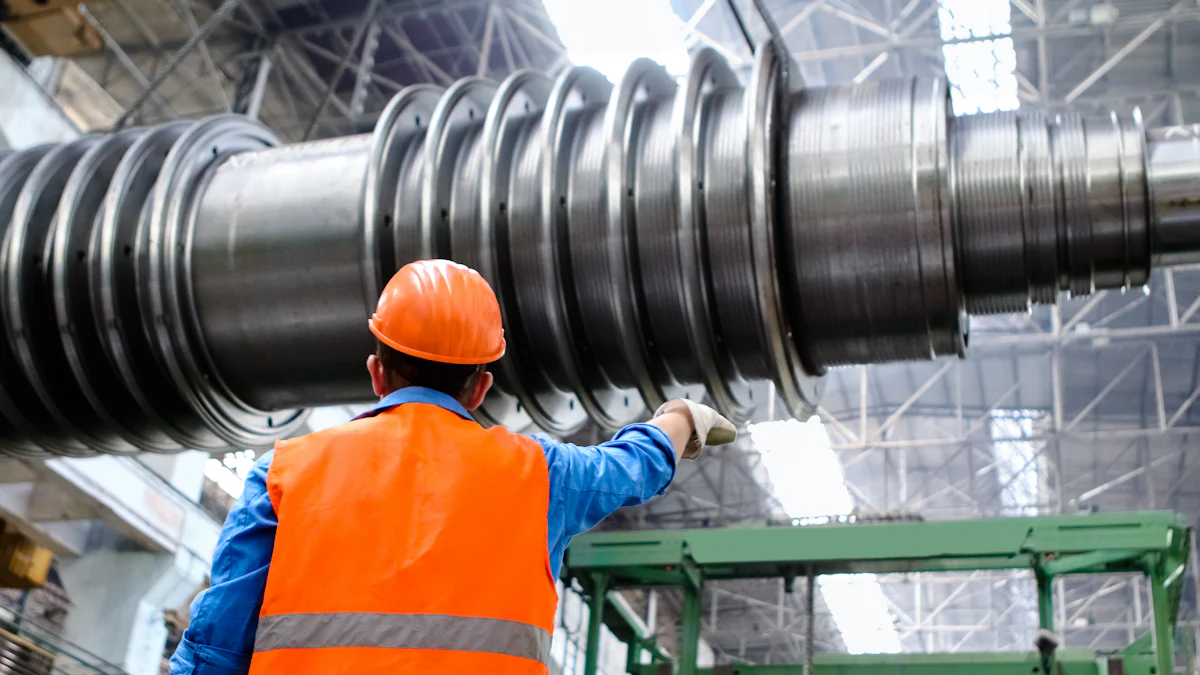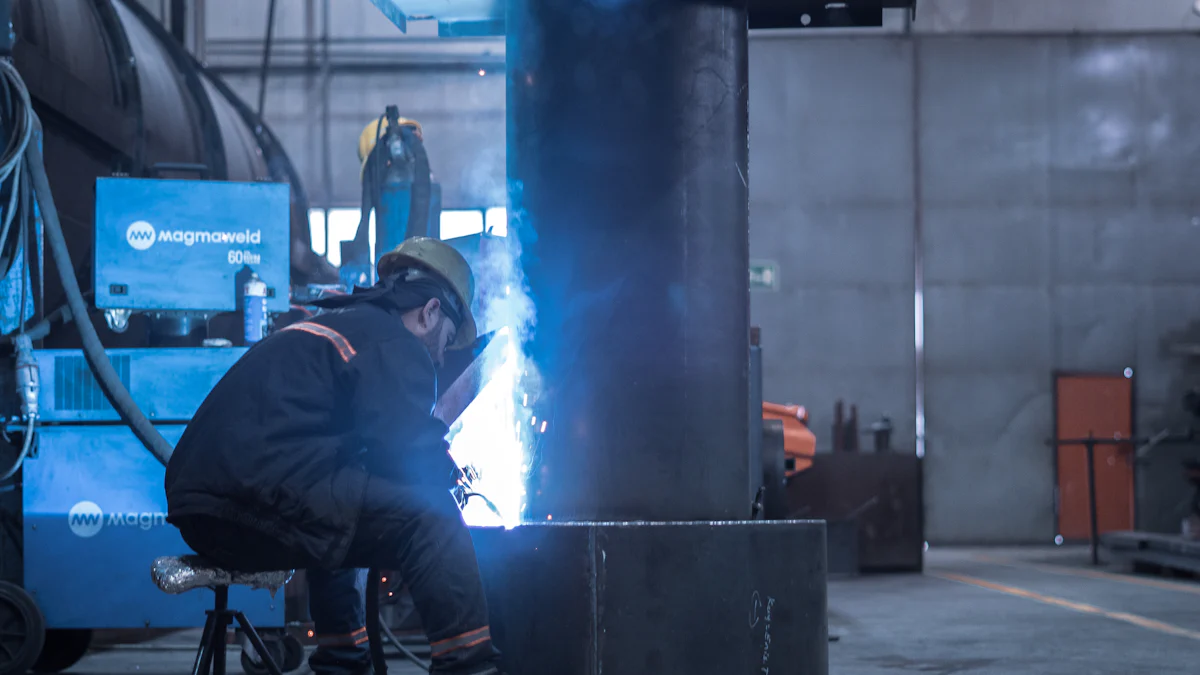7 Steps to Partner with an overseas One-Stop Diecast Factory

Outsourcing to a one-stop diecast factory offers businesses a strategic way to source diecast manufacturing while cutting costs and maintaining high-quality standards. These factories streamline production by integrating multiple processes under one roof, reducing material waste and post-processing needs. By focusing on cost efficiency and quality improvement, companies can enhance their competitiveness in the market. A structured approach ensures smooth collaboration, enabling businesses to design products with precision and prevent costly errors. This method not only optimizes production but also fosters long-term partnerships that deliver economical and reliable solutions.
Key Takeaways
Clearly define your manufacturing needs, including product specifications and budget expectations, to set the stage for a successful partnership.
Research and select one-stop diecast factories that offer integrated services, ensuring efficiency and reduced costs.
Evaluate factory capabilities by reviewing quality certificates, samples and testing communication to ensure alignment with your quality standards.
Negotiate clear terms regarding pricing and payment to manage manufacturing costs effectively and foster trust.
Implement robust quality control measures, including safeguarding all relevant toolings, inspection protocols and third-party audits, to maintain high product standards.
Maintain regular communication and updates throughout the production process to address issues promptly and keep projects on track.
Build a long-term partnership by evaluating post-production performance and fostering collaboration for future projects.
Are you outsourcing in another country for the first time? Pay extra attention to setting a clear business requirement, localisation of your company approach and supervise the centralised engineering knowledge.
Step 1: Define Your Manufacturing Needs to Reduce Manufacturing Costs
A clear understanding of manufacturing needs forms the foundation for a successful partnership with a diecast factory. Businesses must invest time in defining their requirements to ensure efficient production and cost savings. This step involves two critical aspects: identifying product specifications and setting budget and timeline expectations.
Identify Product Specifications
Product specifications serve as a blueprint for the manufacturing process. They outline the essential details, such as dimensions, materials, and performance standards, ensuring that the final product meets customer expectations. Companies should create a comprehensive specification sheet that adheres to the SMART criteria—specific, measurable, achievable, relevant, and time-bound. This approach minimizes errors during production and enhances communication with the factory.
For example, including precise measurements and material requirements helps the factory source the right components and avoid unnecessary delays. Additionally, businesses should consider past quality issues and incorporate lessons learned into the specifications. By designing with quality in mind, companies can reduce rework and associated costs, ultimately lowering manufacturing costs.
Set Budget and Timeline Expectations
Establishing a realistic budget and timeline is equally important. Manufacturing costs are heavily influenced by decisions made during the planning stage. Companies should allocate sufficient time to evaluate their financial resources and determine how much they can invest in production. A well-defined budget prevents overspending and ensures that resources are used efficiently.
Timelines should account for all stages of production, from initial design to final delivery. Businesses must communicate these expectations clearly to the factory to avoid misunderstandings. Factories with integrated processes, like one-stop diecast facilities, can often streamline production and meet tight deadlines. However, flexibility in timelines may be necessary to accommodate unforeseen challenges.
By addressing these two aspects—product specifications and budget/timeline expectations—companies can lay the groundwork for a smooth manufacturing process. This preparation not only reduces costs but also fosters a productive relationship with the diecast factory.
Step 2: Research and Source Diecast Factories

Finding the right diecast factory requires thorough research and evaluation. This step ensures that businesses select a reliable partner capable of meeting their manufacturing needs. By focusing on specific criteria, companies can streamline the process of identifying suitable factories for offshore manufacturing.
Focus on One-Stop Diecast Factories
One-stop diecast factories simplify the manufacturing process by integrating multiple services under one roof. These facilities handle everything from tooling and die casting to secondary processes such as CNC machining, coating and so on. This comprehensive approach reduces the need for outsourcing additional processes, saving time and minimizing costs. When sourcing diecast factories, companies should prioritize those offering end-to-end solutions. This strategy eliminates the complexities of coordinating with multiple vendors and enhances overall efficiency.
Evaluate Factory Reputation and Certifications
A factory's reputation and certifications serve as indicators of its reliability and quality standards. Businesses must assess these factors to ensure they partner with a trustworthy manufacturer. Start by reviewing customer testimonials, case studies, and online reviews. Positive feedback from previous clients often reflects the factory's ability to deliver consistent results.
Certifications also play a crucial role in evaluating a factory's credibility. Look for ISO, ITAF and environment certifications, which demonstrate adherence to international quality management standards. Factories with these certifications prioritize quality assurance and continuous improvement. For large projects, use third-party audit to implement Rapid Plant Assessment could also be beneficial to have a comprehensive understanding of the factory's production process and system.
Additionally, businesses should verify the factory's experience in handling offshore manufacturing projects. Factories with a proven track record in this area understand the unique challenges of working with international clients. They are better equipped to navigate cultural and operational differences, ensuring smooth collaboration.
By focusing on one-stop diecast factories and evaluating their reputation and certifications, companies can confidently source diecast manufacturers that align with their goals. This careful selection process lays the foundation for a successful and cost-effective partnership.
Step 3: Assess Factory Capabilities and Compatibility
Evaluating a factory's capabilities and compatibility ensures that the chosen partner can meet production requirements and align with business goals. This step involves reviewing tangible outputs and testing communication efficiency to establish a reliable partnership.
Review Samples and Portfolios
Examining samples and portfolios provides insight into the factory's expertise and production quality. Businesses should request physical samples or detailed images of previous projects. These examples showcase the factory's ability to meet specific design and quality standards.
A comprehensive portfolio often highlights diverse projects, demonstrating versatility and technical proficiency. For instance, factories specializing in die casting may display products with intricate designs, precise dimensions, and smooth finishes. Reviewing these details helps businesses determine if the factory can replicate their desired outcomes.
Tip: Look for consistency in quality across multiple samples. Consistency indicates robust manufacturing processes and attention to detail.
Additionally, businesses should inquire about the factory's experience with similar products. Factories with relevant expertise are more likely to understand unique requirements and deliver satisfactory results. This step minimizes risks and ensures alignment with production expectations.
Test Communication and Responsiveness
Effective communication forms the backbone of a successful partnership. Businesses must evaluate how promptly and clearly the factory responds to inquiries. Quick and accurate responses reflect the factory's commitment to collaboration and problem-solving.
Testing communication can involve sending detailed questions about production capabilities, timelines, or materials. Factories that provide thorough and timely answers demonstrate professionalism and reliability. Clear communication reduces misunderstandings and ensures smooth project execution.
Key Insight: Factories with strong communication skills often excel in addressing challenges during production. Their responsiveness helps resolve issues quickly, preventing delays and additional costs.
Cultural and language differences may influence communication. Businesses should assess whether the factory has staff proficient in the required language or employs translators. This capability enhances mutual understanding and fosters a productive working relationship.
By reviewing samples and testing communication, businesses can assess a factory's capabilities and compatibility effectively. These evaluations ensure that the chosen partner aligns with quality expectations and operational needs, laying the groundwork for a successful collaboration.
Step 4: Negotiate Terms to Manage Manufacturing Costs
Negotiating terms with a diecast factory is a critical step in managing production costs effectively. This process ensures that both parties align on financial expectations and operational responsibilities, creating a foundation for a successful partnership.
Discuss Pricing and Payment Terms
Pricing discussions play a pivotal role in controlling production costs. Businesses should request a detailed breakdown of costs, including tooling, materials, labor, and any additional services. This transparency helps identify areas where adjustments can lead to lower costs without compromising quality. For instance, opting for bulk orders or simplifying product designs may reduce expenses.
Payment terms also require careful consideration. Companies should explore flexible options, such as installment payments or milestone-based payments, to manage cash flow efficiently. Factories often accommodate these arrangements, especially when businesses demonstrate reliability and long-term potential. Clear communication about payment schedules and methods ensures mutual understanding and prevents disputes.
Tip: Always compare quotes from multiple factories to gauge market rates. This practice strengthens negotiation leverage and ensures cost-effective manufacturing solutions.
Additionally, businesses should inquire about potential discounts for early payments or long-term commitments. Factories may offer incentives to secure steady partnerships, further reducing overall production costs.
Establish a Clear Contract
A well-drafted contract solidifies the terms agreed upon during negotiations. This document should outline all aspects of the partnership, including pricing, payment schedules, production timelines, and quality standards. Clarity in these terms minimizes misunderstandings and protects both parties' interests.
Contracts should also address contingencies, such as delays or defects. Including clauses for penalties or corrective actions ensures accountability and maintains production efficiency. For example, a clause might specify that the factory must rectify defective products at no additional cost within a set timeframe.
Key Insight: Contracts often serve as the "entire agreement" between parties, meaning they supersede prior discussions. Amendments or modifications should only occur through written agreements signed by authorized representatives, such as the General Manager or President of the factory.
Businesses should seek legal advice when drafting contracts to ensure compliance with local and international laws. This step safeguards against potential disputes and reinforces the partnership's stability.
By discussing pricing and payment terms and establishing a clear contract, businesses can effectively manage production costs. These measures not only ensure financial transparency but also foster trust and collaboration with the diecast factory.
Step 5: Implement Quality Control Measures

Implementing robust quality control measures ensures that the manufacturing process consistently delivers high standards. This step focuses on defining inspection protocols and utilizing third-party audits when necessary to maintain product quality and minimize operational costs.
Define Inspection Protocols
Inspection protocols act as a structured guide for evaluating product quality at various stages of production. Businesses should establish clear and detailed procedures to ensure that every product meets the required specifications. These protocols should include checkpoints during critical phases, such as raw material inspection, in-process checks, and final product evaluation.
For example, during raw material inspection, factories can verify the composition and dimensions of materials to prevent defects later in production. In-process checks allow manufacturers to identify and address issues before they escalate, reducing waste and rework. Final product evaluations ensure that the finished items align with customer expectations and industry standards.
Tip: Use measurable criteria, such as tolerance levels and performance benchmarks, to make inspections objective and reliable.
Training factory staff on these protocols enhances their ability to identify deviations and take corrective actions promptly. Businesses should also document inspection results to track trends and improve future processes. This systematic approach strengthens quality assurance and ensures consistent outcomes.
Use Third-Party Audits (if needed)
Third-party audits provide an additional layer of quality assurance by offering unbiased evaluations of the manufacturing process. These audits involve independent experts who assess the factory's adherence to agreed-upon standards and protocols. Businesses can use this method to verify compliance with specifications and identify areas for improvement.
Third-party auditors often examine various aspects, including production techniques, equipment maintenance, and workforce competency. Their findings help businesses address potential risks and enhance product quality. For instance, an audit may reveal inefficiencies in a specific process, enabling the factory to implement targeted solutions.
Key Insight: Third-party audits are particularly valuable for offshore manufacturing, where businesses may face challenges in monitoring operations directly.
While audits incur additional costs, they can prevent expensive errors and delays in the long run. Businesses should consider this option for high-value projects or when working with new manufacturing partners. By leveraging third-party expertise, companies can ensure that operational costs remain under control while maintaining high-quality standards.
By defining inspection protocols and incorporating third-party audits when necessary, businesses can safeguard product quality and streamline production. These measures not only enhance reliability but also foster trust between companies and their manufacturing partners.
Step 6: Monitor Production and Communication
Effective monitoring and communication ensure that the production process stays on track and meets quality expectations. Businesses must adopt a proactive approach to maintain alignment with their diecast factory.
Maintain Regular Updates
Regular updates play a vital role in keeping the production process transparent and efficient. Businesses should establish a structured system for receiving progress reports from the factory. These updates can include details about production milestones, material usage, and any potential delays. Frequent communication helps identify issues early, allowing businesses to take corrective actions before they escalate.
Factories often use digital tools to share updates, such as project management software or email reports. Businesses should request visual evidence, like photos or videos, to verify progress. This practice ensures that the factory adheres to agreed-upon timelines and quality standards.
Tip: Schedule weekly or bi-weekly check-ins to review progress and address any concerns. Consistent interaction fosters accountability and strengthens the partnership.
By maintaining regular updates, businesses can stay informed about every stage of production. This approach minimizes surprises and ensures that the final product aligns with expectations.
Address Issues Promptly
Addressing issues promptly prevents minor problems from becoming costly setbacks. Businesses must act quickly when discrepancies arise during production. Immediate action demonstrates commitment to quality and reinforces trust with the factory.
When an issue occurs, businesses should communicate it clearly to the factory. Provide detailed descriptions, including photos or measurements, to help the factory understand the problem. Factories with lean processes often respond faster, as they prioritize efficiency and waste reduction.
Key Insight: Lean manufacturing principles emphasize continuous improvement and quick problem-solving. Factories that follow these principles are better equipped to handle challenges effectively.
Businesses should also document all issues and resolutions. This record helps identify recurring problems and implement long-term solutions. For example, if a specific material consistently causes defects, businesses can work with the factory to find alternatives.
By addressing issues promptly, businesses can maintain production quality and avoid unnecessary delays. This proactive approach ensures that the manufacturing process remains smooth and cost-effective.
Step 7: Build a Long-Term Partnership with Your Diecast Factory
Establishing a long-term partnership with a diecast factory ensures consistent quality and reliability for future projects. This step focuses on evaluating the factory's performance after production and fostering collaboration to strengthen the relationship.
Evaluate Post-Production Performance
Post-production evaluation provides valuable insights into the factory's capabilities and areas for improvement. Businesses should assess the final product's quality, delivery timelines, and adherence to agreed specifications. This evaluation helps determine whether the factory met expectations and delivered value.
Start by reviewing the finished products against the original specifications. Check for consistency in dimensions, material quality, and overall craftsmanship. Any deviations should be documented and discussed with the factory to identify root causes and prevent recurrence.
Tip: Use customer feedback to gauge product performance in real-world applications. This feedback highlights potential improvements and enhances future designs.
Delivery performance also plays a critical role in post-production evaluation. Businesses should analyze whether the factory met deadlines and maintained transparency during the process. Timely delivery reflects the factory's efficiency and commitment to meeting client needs.
Additionally, businesses should review communication during production. Factories that provided regular updates and resolved issues promptly demonstrate strong collaboration skills. This behavior builds trust and sets the stage for a long-term partnership.
Foster Collaboration for Future Projects
Collaboration ensures that both parties continue to benefit from the partnership. Businesses should maintain open communication with the factory to explore opportunities for future projects. Regular discussions about upcoming needs and market trends help align goals and foster innovation.
Customization often becomes a key focus in long-term partnerships. Businesses should work closely with the factory to develop tailored solutions that meet specific requirements. For example, factories can adjust production processes or materials to create unique products that stand out in the market.
Key Insight: Factories with flexible capabilities often excel in delivering customized solutions, enhancing their value as long-term partners.
Investing in joint development initiatives strengthens collaboration further. Businesses and factories can co-develop new products or improve existing ones, leveraging each other's expertise. This approach not only enhances product quality but also deepens the partnership.
Recognizing the factory's contributions also fosters goodwill. Businesses should acknowledge achievements, such as meeting tight deadlines or exceeding quality expectations. Positive reinforcement motivates the factory to maintain high standards and prioritize the partnership.
By evaluating post-production performance and fostering collaboration, businesses can build a strong, long-term relationship with their diecast factory. This partnership ensures consistent results, supports innovation, and drives mutual growth.
Are you outsourcing in another country for the first time?
Depending the project size and long-term development plan, the collaboration depth can varies from stand-alone outsourcing, setting on-site project manager or representative, to establish a localised company to conduct procurement activities.
Learning from our project experiences at Hunan Puka, we would genuinely suggest our new clients to pay extra attention in the following aspects:
Business requirement:
consider the constructions of total land costs, which are fixed and variable, visible and invisible, especially the import taxes.
consider whether to keep a original mold at mother country if you are outsource the production for the first time.
Quotation phase:
Combing different scenarios for product delivery life cycle and volumes. This could be crucial for factory to give more flexible price levels and delivery schedule.
On-site audit and sample production:
Communicating the standard difference between two parties and ensuring a mutual understanding of same quality standards.
Safeguarding the availability of relevant work tools.
Localising company approach (for long-term partnership):
Communicating your sourcing policy, required corresponding workflow from supplier side regularly.
Seek systematic advice from local procurement service providers to shorten the learning curve.
supervise the centralised engineering knowledge (for first-time project):
For large companies, while one-stop die cast factory autonomously conduct and manage the production part, it will be beneficial if the outsourcer company supervise and centralize the engineering-related knowledge to identify collaboration improvement potentials.
Partnering with a one-stop diecast factory becomes seamless by following these seven structured steps. Preparation, communication, and quality control emerge as the cornerstones of success. Defining manufacturing needs, researching reliable factories, and implementing robust quality measures ensure businesses reduce manufacturing costs while maintaining high standards. Standardization in processes further streamlines production and minimizes errors.
Outsourcing to a one-stop diecast factory not only reduces manufacturing costs but also enhances efficiency and fosters long-term partnerships. Businesses should take the first step by clearly identifying their requirements and exploring potential factories to unlock cost-effective and reliable manufacturing solutions.
FAQ
What is die casting, and why is it important?
Die casting is a manufacturing process that involves forcing molten metal into a mold cavity under high pressure. This method produces precise, durable, and high-quality components used in various industries, including automotive, aerospace, and consumer electronics. Its importance lies in its ability to create complex shapes with excellent dimensional accuracy and surface finish, making it a preferred choice for mass production.
How does partnering with a one-stop diecast factory benefit businesses?
Partnering with a one-stop diecast factory streamlines the production process by consolidating multiple services under one roof. These factories handle everything from tooling and die casting to secondary operations and quality control. This integration reduces lead times, minimizes costs, and ensures consistent quality, making it an efficient solution for businesses seeking reliable manufacturing partners.
How can companies ensure quality control during the manufacturing process?
Companies can implement robust quality control measures by defining clear inspection protocols and conducting regular checks at various production stages. Utilizing third-party audits provides an unbiased evaluation of the factory's adherence to quality standards. These steps help maintain product consistency and minimize defects.
Why is effective communication crucial in die casting partnerships?
Effective communication ensures alignment between businesses and diecast factories throughout the production process. Regular updates, clear instructions, and prompt issue resolution prevent misunderstandings and delays. Factories with strong communication skills often excel in addressing challenges, fostering trust and collaboration.
What role does sustainability play in modern die casting?
Sustainability has become a critical focus in die casting, with manufacturers adopting eco-friendly practices to reduce environmental impact. This includes using recyclable materials, minimizing waste, and improving energy efficiency. Businesses increasingly prioritize these factors when selecting manufacturing partners to align with their corporate social responsibility goals.
How can businesses build long-term partnerships with diecast factories?
Building long-term partnerships involves evaluating post-production performance, maintaining open communication, and fostering collaboration on future projects. Recognizing the factory's contributions and investing in joint development initiatives strengthen the relationship. These efforts ensure consistent quality and reliability for ongoing and future manufacturing needs.

